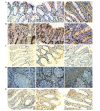Analysis of different components in the peritumoral tissue microenvironment of colorectal cancer: A potential prospect in tumorigenesis
- PMID: 27484148
- PMCID: PMC4991672
- DOI: 10.3892/mmr.2016.5584
Analysis of different components in the peritumoral tissue microenvironment of colorectal cancer: A potential prospect in tumorigenesis
Erratum in
-
[Corrigendum] Analysis of different components in the peritumoral tissue microenvironment of colorectal cancer: A potential prospect in tumorigenesis.Mol Med Rep. 2016 Dec;14(6):5429. doi: 10.3892/mmr.2016.5882. Epub 2016 Oct 25. Mol Med Rep. 2016. PMID: 27779680 Free PMC article.
Abstract
The present study aimed to observe the varying expression of biomarkers in the microenvironment adjacent to colorectal cancer lesions to provide additional insight into the functions of microenvironment components in carcinogenesis and present a novel or improved indicator for early diagnosis of cancer. A total of 144 human samples from three different locations in 48 patients were collected, these locations were 10, 5 and 2 cm from the colorectal cancer lesion, respectively. The biomarkers analyzed included E‑cadherin, cytokeratin 18 (CK18), hyaluronidase‑1 (Hyal‑1), collagen type I (Col‑I), Crumbs3 (CRB3), vimentin, proteinase activated receptor 3 (PAR‑3), α‑smooth muscle actin (α‑SMA), cyclin D1 (CD1) and cluster of differentiation (CD)133. In addition, crypt architecture was observed. Related functional analysis of proteins was performed using hierarchical index cluster analysis. More severe destroyed crypt architecture closer to the cancer lesions was observed compared with the 10 cm sites, with certain crypts degraded entirely. Expression levels of E‑cadherin, CK18, CRB3 and PAR‑3 were lower in 2 cm sites compared with the 10 cm sites (all P<0.001), while the expression levels of the other biomarkers in the 2 cm sites were increased compared with 10 cm sites (all P<0.0001). Notably, the expression of CK18 in 2 cm sites was higher than in the 5 cm site (P<0.0001), which was different from the expression of E‑cadherin, CRB3 and PAR‑3. The expression levels of Hyal‑1 and Col‑I at the 2 cm sites were lower than that of the 5 cm sites (P>0.05 and P=0.0001, respectively), while the expression of vimentin, α‑SMA, CD1 and CD133 were not. Hyal‑1 and Col‑I may be independently important in cancer initiation in the tumor microenvironment. The results of the present study suggest that the biomarkers in the tissue microenvironment are associated with early tumorigenesis and may contribute to the development of carcinomas. These observations may be useful for early diagnosis of colorectal cancer.
Figures






Similar articles
-
Differential expression of cytokeratin 14 and 18 in bladder cancer tumorigenesis.Exp Biol Med (Maywood). 2018 Feb;243(4):344-349. doi: 10.1177/1535370218754493. Epub 2018 Jan 19. Exp Biol Med (Maywood). 2018. PMID: 29350066 Free PMC article.
-
[Expression of CD10 in cancer-associated fibroblasts and its effect on initiation and progression of colorectal carcinoma].Zhonghua Bing Li Xue Za Zhi. 2016 Dec 8;45(12):859-865. doi: 10.3760/cma.j.issn.0529-5807.2016.12.009. Zhonghua Bing Li Xue Za Zhi. 2016. PMID: 28056302 Chinese.
-
Expression of DNA methyltransferases and target microRNAs in human tissue samples related to sporadic colorectal cancer.Oncol Rep. 2016 Nov;36(5):2705-2714. doi: 10.3892/or.2016.5104. Epub 2016 Sep 19. Oncol Rep. 2016. PMID: 27666771
-
Prognostic value and clinicopathological significance of serum- and tissue-based cytokeratin 18 express level in breast cancer: a meta-analysis.Biosci Rep. 2018 Mar 21;38(2):BSR20171145. doi: 10.1042/BSR20171145. Print 2018 Apr 27. Biosci Rep. 2018. PMID: 29437899 Free PMC article. Review.
-
The immune microenvironment of the colorectal tumor: Involvement of immunity genes and microRNAs belonging to the TH17 pathway.Biochim Biophys Acta. 2015 Aug;1856(1):28-38. doi: 10.1016/j.bbcan.2015.04.001. Epub 2015 Apr 21. Biochim Biophys Acta. 2015. PMID: 25911397 Review.
Cited by
-
Fungal influence on immune cells and inflammatory responses in the tumor microenvironment (Review).Oncol Lett. 2024 Nov 11;29(1):50. doi: 10.3892/ol.2024.14796. eCollection 2025 Jan. Oncol Lett. 2024. PMID: 39564373 Free PMC article. Review.
-
Mesentery morphological features on computed tomography for preoperative prediction of tumor invasion and lymph node metastasis in colon cancer.World J Clin Oncol. 2025 Jul 24;16(7):108095. doi: 10.5306/wjco.v16.i7.108095. World J Clin Oncol. 2025. PMID: 40741198 Free PMC article.
References
-
- Paget S. The distribution of secondary growths in cancer of the breast 1889. Cancer Metastasis Rev. 1989;8:98–101. - PubMed
LinkOut - more resources
Full Text Sources
Other Literature Sources
Research Materials

